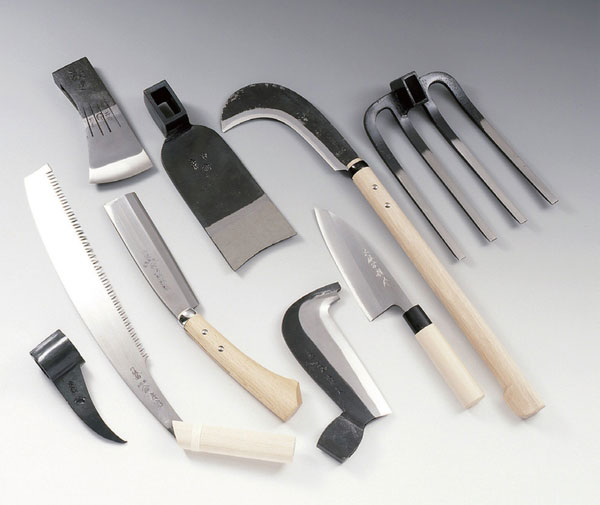 Photo:kochi Prefecture
Photo:kochi Prefecture
- Metal works
- Kochi
Tosa cutlery Tosa uchihamono
Blades forged by traditional artisans
The quality of years of experience
Description
What is Tosa cutlery ?
Tosa cutlery (called Tosa uchihamono in Japanese) are hammer-forged blades produced in the eastern to central part of Kochi prefecture, including the town of Ino and the cities of Kami, Nankoku, Tosa, and Susaki. Kochi prefecture was once a province called Tosa, which is the origin of the name Tosa uchihamono and only blades made by following the traditional process can claim to be the authentic craft.
This craft is distinctive for free-forging in which shapes are formed by the painstaking hammering and flattening of hot metal. These artisans can make any size or shape of blade in small production runs and be requested to make any item ranging from small kitchen knives to full-size forestry saws so they spend many years developing their skills. In addition, Tosa cutlery evolved from practical tools used in forestry and agriculture. Therefore, the blades are renowned for not only their sharpness, but also durability and low-maintenance. The main product range includes kitchen knives, sickles, hatchets, axes, and hoes.
History
Kochi prefecture, once Tosa province, is blessed with an abundance of forests and the region has made the hammer-forged blades needed for tree felling for years. In 1306, a group of artisans practicing the Gorozaemon Yoshimitsu sword-making style moved to Tosa from Yamato province (now Nara prefecture) and flourished, particularly during the Sengoku period (1467-1568) when they supplied weapons and swords for the near-constant military conflict. Over time, the newly introduced sword-making techniques spread to artisans in the province who already made hammer-forged blades for agriculture and forestry which can be seen in historical documents from 1590 that record 399 blacksmiths in Tosa. But the full-scale development of Tosa cutlery only started in 1621, when the domain started experiencing economic hardship and embarked on the development of new rice fields and the practical use of its forest resources. This revival of the local economy created an increased demand for hammer-forged blades in agriculture and forestry leading to a dramatic improvement of production volume and quality of the blades. The trial and error of local blacksmiths at that time led to the techniques still used today. This tradition, continued from the Edo period (1603-1868), has been passed down through the generations and artisans continue to develop the craft.
Production Process
- 1. Splitting charcoal
Charcoal is split to a uniform size to allow accurate control of the fire when feeding air from a bellows to a furnace. The aim is to maintain a temperature high enough to work steel and iron. It is said to take three years to master the skill of splitting charcoal.
- 2. Preparing steel and iron
Tosa cutlery has a metal inserting process. First, a length of steel for the blade edge is prepared. Then, a long groove is made along the thin edge of an iron strip and the steel is inserted into the groove and lightly hammered. Boric acid is applied as an adhesive and the metal is put into the fire.
- 3. Forge welding
After heating in the furnace, the metal is hammered to weld the steel and iron together. Placing hard steel between soft iron prevents the steel from breaking. Recently, some production centers use a ready-made combination of steel and iron.
- 4. Forging and shaping
The welded blade is heated until red-hot and placed on an anvil, where the blade is beaten into shape by using a belt hammer. An anvil is a stand used for hammering, and a belt hammer is a high-speed rotary machine hammer developed during the Showa period (1926-1989), which has significantly helped increase production volume. After belt-hammering, the shapes of the detailed parts are adjusted with a traditional hammer. This style of hammer work is known as free-forging and requires a lot of experience and skill.
- 5. Rough grinding
The forged blade is ground using a high-speed rotary grinder to create a well-balanced shape.
- 6. Mud coating
The blade is evenly coated with mud to ensure good quenching.
- 7. Quenching and tempering
Quenching is an important task that determines the hardness of the blade. After heating the blade in the hardening furnace at 770 to 800℃ (1418 to 1472℉), it is quenched and hardened by quickly plunging into water.
A hard blade is brittle and will snap but tempering adds durability and toughness to the metal. A low-temperature tempering furnace is set to about 170℃ (338℉) using heated fuel oil, and slowly heats the the blade before being removed and allowed to cool naturally.
- 8. Removing distortion
Any distortion resulting from the quenching and tempering is removed by careful hammering of the face and back of the blade.
- 9. Blade edging and finishing
Finally, the blade is carefully sharpened from rough and semi-finish down to a fine-grinded blade.
Generally in the blade-making industry, division of labor is becoming more common. In contrast, Tosa cutlery is made by one artisan for the entire production process.
Facility Information
Kochi Jibasan Center
-
Address
-
Tel.+81-88-846-0311
-
ClosedSaturdays, Sundays, national holidays, around the New Year
-
Business Hours9am to 5pm
-
Website
Other Metal works
- Nambu ironware
- Takaoka copperware
- Yamagata cast iron
- Sakai cutlery
- Tokyo silverware
- Echizen cutlery
- Osaka naniwa pewterware
- Tosa cutlery
- Tsubame-tsuiki copperware
- Shinshu Forged Blades
- Banshu-miki cutlery
- Higo inlays
- Echigo-sanjo cutlery
- Echigo-yoita cutlery
- Chiba Artisan Tools
- Tokyo antimony craft

































































































































































































































































































